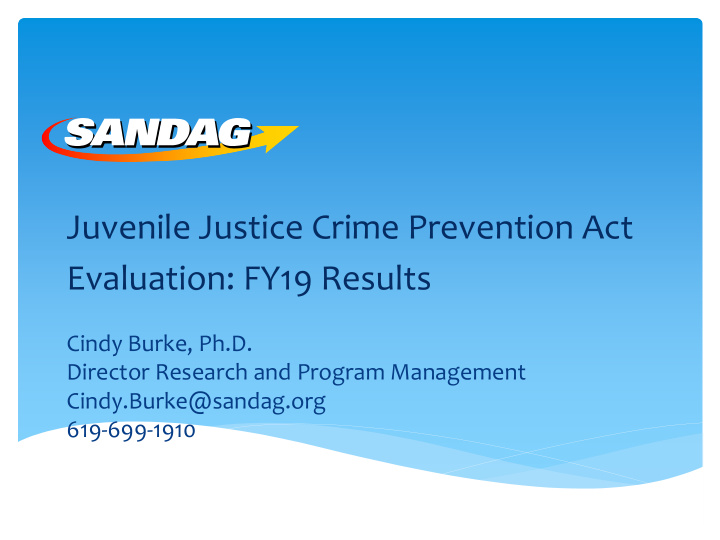



Juvenile Justice Crime Prevention Act Evaluation: FY19 Results Cindy Burke, Ph.D. Director Research and Program Management Cindy.Burke@sandag.org 619-699-1910
What Information is Presented? ∗ Evaluation design ∗ Changes to JJCPA ∗ Characteristics of JJCPA participants ∗ Outcome Results for FY 18-19 2
JJCPA Programs Historical Timeline FY 02 FY 05 FY 09 FY 13 FY18 thru thru thru FY 2004 thru FY thru FY FY 19 12 17 FY 03 FY 08 CAT CAT CAT CAT CAT CAT TSP TSP TSP SAS CYC TSP SAS SAS WINGS ROPP BC BC BC BC ROPP BC DC DC BC DC/PMSA DC DC/PMSA JFAST JFAST DC 3
BSCC Required Evaluation Elements Recidivism During Program Compliance ∗ Payment of restitution ∗ Arrests ∗ Probation completion ∗ Sustained petitions new ∗ Completion of community offense service ∗ Probation violations ∗ Institutional commitments 4
Non-Mandated Evaluation Elements ∗ Number of referrals to Probation ∗ Level and type of highest referral charge ∗ Level and type of highest sustained petition ∗ SDRRCII Strength Index (NEW to FY 19 report) ∗ Program-specific outcomes ∗ JFAST psychotherapy intervention outcomes ∗ SAS/DC drug test outcomes ∗ Satisfaction outcomes 5
Limitations to Evaluation ∗ Smaller enrollment and exit numbers ∗ Compared to "what"? ∗ Data limited to "during participation" ∗ Sealed data was not fully accessible for this report year (limitations to collecting in PCMS for drug test information) ∗ Breaking Cycles administratively ended, which increased overall sample for comparison year to year 6
Characteristics by Program CAT SAS BC DC JFAST n=2,590 n=94 n=164 n=23 n=22 AGE (Mean age at 12.9 years 16.2years 16.2 years 15.6 years 15.6 years intake) % MALE 54% 80% 84% 61% 45% % WHITE 20% 27% 9% 30% 59% 7
CAT Outcomes (Pages 6-7, 17-19) ∗ 5,765 youth referred and 2,924 enrolled ∗ Average 87 days enrolled ∗ FY 20 and FY 21 program 2%-3% <1%-2% 0%-1% 0%-<1% FY 15-18 FY 15-18 FY 15-18 FY 15-18 1% 1% <1% 0% 0% Arrest Referral Sustained Institutional Petition Commitment 8
Additional Local Measures – CAT Youth and Parent Customer Satisfaction Pre/Post Results Youth Responses Parent Responses Pre Post Pre Post Regularly attending school 97% 99% Family communicates well/very 51% 88% well Doing well/very well in 65% 92% Feels youth is doing well/very 47% 83% school well in school Feels positive about school 62% 82% Friends are a positive influence 55% 85% Handles problems with 70% 95% others well Would refer a friend’s family to 98% the program Would refer a friend to the 95% program Somewhat/very satisfied with 96% Somewhat/very satisfied 96% program services with program services 9
SAS 5-year Outcomes (Pages 8-9, 20-21) ∗ 351 entered 20% FY 15-18 11%-19% 15% 14% ∗ Average 173 days enrolled FY 15-18 4%-11% 10% FY 15-18 8% ∗ FY 20 and FY 21 program 2%-7% FY 15-18 1%-4% 5% 4% 3% 0% Arrest Referral Sustained Institutional Petition Commitment 10
Additional Local Measures – SAS Client Satisfaction Questionnaire Results Good relationship Treated with respect Staff concerned with with JRS well-being (96%) (91%) (94%) Satisfied with Staff expectations program experience clear (88%) (89%) 11
Breaking Cycles 5-year Outcomes (p. 12-13, 23) ∗ 90 administrative 25% FY 15-18 discharges and 74 true 9%-18% 20% FY 15-18 exits FY 15-18 2%-13% 16% 12%-22% 15% 13% 13% FY 15-18 ∗ Average 5 months 2%-7% 9% 10% enrolled 5% ∗ Not included in FY 20 or 0% FY 21 Arrest Referral Sustained Institutional Petition Commitment 12
Breaking Cycles Deep Dive May 2019 ∗ Youth with new BC commitment between July 1, 2015 and June 30, 2018 (n=750) ∗ Follow-up for 18-months post-program exit ∗ 35% had sustained petition and 67% a commitment ∗ Prior involvement in system greatest predictor of recidivism ∗ 48% of new true findings within 6 months of release from custody 13
Drug Court 5-year Outcomes (p. 10-11 , 22) ∗ 29 entered 25% FY 15-18 0%-18% 20% FY 15-18 17% 4% to 26% ∗ Average 14 months 14% 15% FY 15-18 enrolled 4%-30% 9% 10% FY 15-18 0%-17% ∗ FY 20 program, not 4% 5% included in FY 21 0% Arrest Referral SustainedPetition Institutional Commitment 14
Drug Court Deep Dive – April 2020 ∗ Youth who exited between July 1, 2018 and March 31, 2019 (n=22) ∗ Follow-up for 6-months post-program exit ∗ Drug tested an average of 47 times with an average of 29% positive drug tests ∗ 41% graduated successfully after average of 432 days in program 15
Drug Court Deep Dive – April 2020 ∗ 14% had a referral, 9% a sustained petition, and 36% a commitment in 6-month follow-up period ∗ Males and youth terminated unsuccessfully were more likely to have a new referral and those who used “other” drugs were more likely to have a new commitment ∗ Report recommendations included reevaluating program delivery and fidelity 16
JFAST 5-year Outcomes (p. 14-15, 24) ∗ 21 entered FY 15-18 30% 0% 23% FY 15-18 4%-31% ∗ Average 9 months FY 15-18 FY 15-18 20% 18% 4%-34% 0%-9% enrolled 14% 14% 10% ∗ FY 20 and 21 program 0% Arrest Referral Sustained Institutional Petition Commitment 17
Additional Local Measures – JFAST Therapy and Medication Compliance 82% Adhered to psychiatric medication 100% Moderate/complete compliance with therapy 18
New Programs/Efforts in FY 20 and FY 21 FY20 FY21 ATD added New three-tier approach to SUD Achievement Centers added Complete RRED study CHOICE added 19
Juvenile Justice Crime Prevention Act Evaluation Cindy Burke, Ph.D. Director Research and Program Management Cindy.Burke@sandag.org 619-699-6910
Recommend
More recommend